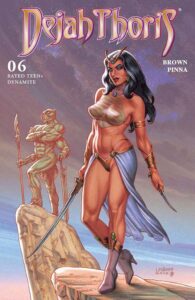It’s weeks like these when I’m reminded of a quote from the legendary Clint Eastwood in the film Magnum Force (1973). At the end of the film, “Dirty” Harry Calahan, played by Clint Eastwood, confronts the last bad guy who thinks he’s gotten away with his crimes. As the villain drives away, his car explodes, and Dirty Harry utters the iconic phrase:

What’s this got to do with comics? Simple. Publishers, editors, writers, artists, marketers, and everyone involved in making a comic are required to develop an instinct about when and how they’ve reached their limitations.
There’s no shame in having limitations. We all have them, including yours truly. The shame is in not acknowledging your limitations and either leveling up to overcome them or seeking help to do what you can’t do on your own.
With apologies in advance to the folks involved in the following examples, let’s take a look at three comics and/or comic events where understanding your limitations would have saved everyone, including yours truly, a lot of headaches.
Bad Things Come In Threes

Knight Terrors Night’s End #1 marks the end of the Knight Terrors event from DC Comics, and it’s safe to say this event turned out to be a dud for several reasons.
First, Knight Terrors needlessly ballooned into a line-wide event that didn’t have a big enough plot to warrant the disruption to in-progress titles and interrupted the barely-started momentum for Dawn of DC titles.
Second, the story was poorly constructed. Full stop. The rules from issue to issue were inconsistent, and ideas introduced at the beginning of the arc either changed midway through or disappeared without a payoff.
Third, we’ve confirmed with multiple sources that creators of the tie-in books were given little to no information, so the tie-ins would often conflict with the main arc or have nothing to do with the main arc.
This is the third major event DC entrusted to Joshua Williamson as the sole architect and the third event in a row that’s flopped. It’s fair to say Williamson has developed a track record of accepting event architect roles that fail.

Batman / Catwoman: Gotham War – Battle Lines #1 from DC Comics marks the beginning of the Gotham War event, co-written by Chip Zdarsky and Tini Howard. To say the reception for this first issue is mixed would be a gross understatement.
The collaboration between Zdarsky and Howard should result in a seamless, blended writing style that encapsulates the strengths of both writers. Sadly, it didn’t work out that way. Clearly, you can tell which page belongs to which writer. Howard’s voice for Catwoamn is wildly out of character, which is a consistent problem with her run on the main Catwoman book. And the plot is a nonsensical mess.
Here, we have an example of DC Comics starting a new event in the same week another event ends. Neither event was positively anticipated, and so far, both have exceeded expectations for the worse.
It’s fair to say that Tini Howard does not know how to write Catwoman, and DC Comics does not have an instinct for planning events.

Dejah Thoris (Vol. 4) #6 ends the latest take on the pulp character from Dynamite Comics. The finale represents a perfect encapsulation of the mini-series as a whole – terrible. Chuck Brown’s plot is nearly non-existent, the arc ends in the middle of the conflict, and Emiliana Pinna’s art doesn’t pass the basic bar for quality at any mainstream publisher.
It pains me to say it, but transparency is key to what we do here. Nothing about this mini-series works. Dynamite could have saved itself a lot of wasted time, energy, and money by either stopping the mini before it went to press or by taking a hefty delay to rework the entire project.
Of the three examples, this one is the most painful because we’re fans of Dynamite, classic pulp characters, and comics. A Dejah Thoris series should be the perfect match for everything we love, so to see Dejah Thoris utterly mishandled is heartbreaking.
Know Your Limitations – The Common Thread
What do these three examples have in common? In all three, you have individuals and teams who either don’t know their limitations or when they reach their limitations, they don’t know how to take a step back and take the time to get help.
Instead, all the folks involved pressed ahead, resulting in bad comics that hurt the characters, hurt the publishers’ brands, and hurt the creators’ reputations.
In the words of a legendary Nintendo game developer:
Well, the same could be said for comics.
“A Delayed Comic Is Eventually Good. A Bad Comic Is Bad Forever.”
Know your limitations, or you’re practically guaranteed no success.
We hope you found this article interesting. Come back for more reviews, previews, and opinions on comics, and don’t forget to follow us on social media:
If you’re interested in this creator’s works, remember to let your Local Comic Shop know to find more of their work for you. They would appreciate the call, and so would we.
Click here to find your Local Comic Shop: www.ComicShopLocator.com
As an Amazon Associate, we earn revenue from qualifying purchases to help fund this site. Links to Blu-Rays, DVDs, Books, Movies, and more contained in this article are affiliate links. Please consider purchasing if you find something interesting, and thank you for your support.


